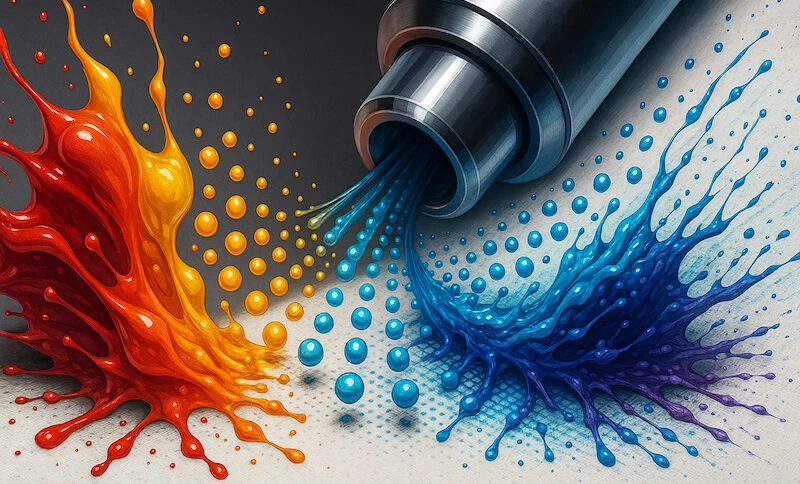When sublimating an image, you expect sharp edges and bold, saturated colors. But print sharpness isn’t determined solely by your printer resolution, it starts with something microscopic: the size and uniformity of ink particles in sublimation ink.
Sublimation ink contains dye particles suspended in a liquid carrier. These particles must pass through extremely fine printhead nozzles, land cleanly on sublimation transfer paper, and then convert to gas during pressing. The smaller and more uniform the particles are, the more precisely the ink can be placed and the more efficiently it vaporizes into polyester fibers.
Why Ink Particle Size Affects Sharpness and Color SaturationSublimation inks are engineered with micro-fine dye particles. Smaller particles flow easily through printheads and form tighter, more controlled dot patterns on the transfer paper. This reduces overspray and bleeding, resulting in cleaner edges. During heat pressing, fine particles fully convert into gas and penetrate polyester fibers more evenly, creating deeper color saturation. Larger or inconsistent particles vaporize unevenly, leading to dull color, fuzzy edges, and clogging.

| ⚠️ Important: Particle size matters before sublimation happens. The image that gets transferred is the image that first forms on the transfer paper. Small particles = sharp dots on paper, and sharp dots on paper = crisp, saturated color once sublimated. |
Key Takeaways
Particle size affects edge definition.
Smaller particles create tighter dot placement on the transfer paper, which produces sharper final prints.
Smaller particles = richer color saturation.
Fine particles sublimate more efficiently, allowing more dye gas to enter polyester fibers and produce deeper, more vivid color.
Uniformity is just as important as size.
Consistent particle size improves ink flow through printheads, reducing clogging and banding lines.
Ink quality determines particle size.
Users don’t choose particle size — they choose it by selecting high-quality sublimation ink with nano-particle dispersion.
Particle Size Defines the Sharpness of Printed Edges
In sublimation printing, edge definition and image clarity begin on the sublimation transfer paper, long before heat pressing. Each droplet that leaves the printhead nozzle carries dye particles suspended in a liquid carrier. When those particles are small and uniform, they form precise dot placement on the transfer paper, reducing dot gain, overspray, and bleeding.
This microscopic control allows the ink to dry cleanly and maintain crisp line boundaries, resulting in a sharply focused image on the transfer sheet. Larger or uneven particles, on the other hand, cause diffusion and inconsistent absorption, producing soft or fuzzy edges even before sublimation occurs.
In short, sharp sublimation prints start on paper, with finely dispersed ink particles that deliver high-resolution detail and clear edge definition ready for flawless transfer.
Smaller Dye Particles Produce Deeper, More Vibrant Colors
During heat activation, sublimation ink transfers color from the printed transfer paper into the polyester fibers of the substrate. When the dye particles are smaller and evenly dispersed, they vaporize efficiently, improving gas conversion and transfer efficiency.
This fine particle structure allows dye gas to penetrate polyester fibers more completely, producing greater color density, higher chroma, and richer tonal depth. The result is vivid output with balanced hue intensity and consistent color saturation across the entire print surface.
Larger or irregular particles, however, sublimate unevenly. Some fail to fully convert to gas, reducing color depth and creating dull or patchy areas. Simply put, smaller dye particles enable complete vaporization and stronger fiber bonding, which translates to deeper, more vibrant color in the finished sublimation print.
Consistent Particle Size Ensures Smooth Ink Flow and Print Reliability
Ink uniformity directly influences flow dynamics and printhead performance. When dye particles are consistent in size and well-dispersed, the ink maintains stable rheology—its ability to flow smoothly through micro-nozzles without interruption.
Stable dispersion minimizes changes in viscosity, preventing clogging and supporting accurate droplet formation. This consistency allows the printer to deposit ink with precise alignment and deposition accuracy, eliminating banding and maintaining clean, even coverage across the substrate.
| 💡 What’s the Difference Between Particle Size and Uniformity?Particle size is the actual diameter of each dye particle, affecting how sharply and vividly the image prints. Uniformity is how consistent those particle sizes are, determining how smoothly the ink flows and how reliably it prints. |
In contrast, inks with uneven or unstable particle dispersion can thicken unpredictably, disrupt nozzle flow, and cause printhead wear or misfiring. Maintaining dispersion stability and particle uniformity is essential for long-term print reliability, reduced maintenance, and consistently smooth production output.
High-Quality Inks Are Engineered with Controlled Nano-particle Dispersion
Premium sublimation inks are developed through advanced nano-dispersion technology, where pigment engineering and chemical milling refine dye particles to a uniform, nano-scale size. This process enhances colloidal stability within the suspension medium, preventing settling or agglomeration that can disrupt print performance.
Manufacturers use precise dispersion agents, surfactants, and nano-encapsulation techniques to maintain even particle spacing and long-term formulation stability. The result is a high-performance sublimation ink with predictable flow behavior, improved color transfer efficiency, and minimal maintenance demands.
In short, consistent manufacturing precision and particle refinement separate ordinary inks from premium ink systems, ensuring every print delivers sharp detail and vibrant, durable color.
Related Topics
